大学英语三级考试大纲
大学英语3级考试题型

大学英语3级考试1. 考试时间120分钟。
2. 题型I Listening Comprehension (25%)Section A eight short conversations and two long conversations (课外)15%Section B three short passages (出自听力课本课文,包括optional listening部分)10% II Reading Comprehension (30%)共3篇阅读理解。
每篇阅读5题选择题,每题2分。
第一篇阅读理解选自快速阅读书中(Unit4、5、6),其余课外。
ⅢVocabulary and Structure (10%)共20题,每题0.5分。
出自《导学导练》task4练习。
ⅣFill in the blanks with the words given below. Change the form where necessary. (5%) 共5题,每题1分。
出自课本课后选词题。
4、5、6、7单元为主。
V Translate the following into English. (15%)共5题,每题3分。
出自课文课后汉译英题。
4、5、6、7单元为主。
ⅥComposition (15%) 作文要求:120字。
3. 考试注意:带上两证。
带耳机、铅笔、橡皮。
作弊0分,处分。
填涂答题卡时,请在答题卡学校栏注明专业、班级。
涂卡使用2B铅笔,请务必填涂清晰,否则机器无法读出,后果自负。
学号栏上方请用签字笔填写格式为“0+学号”,下方用铅笔对应填涂清晰。
大学三级(A)-(暂无语音,只提供参考)2

大学三级(A)-(暂无语音,只提供参考)2(总分:116.00,做题时间:90分钟)一、Part Ⅰ Listening Comprehension(总题数:0,分数:0.00)二、Section A(总题数:1,分数:5.00)(分数:5.00)(1).A) At a bank. B) At a restaurant.C) At a friend' s house. D) At a hotel.(分数:1.00)A.B. √C.D.解析:[听力原文]W: Are you ready to order soup?M: Yes. I'd like to have some vegetable soup.Q: Where are the two speakers?[答案精解] 该题为判断对话场合题,根据文中“order soup”,“vegetable soup”等关键词可知两人在餐馆里。
(2).A) Get some changes from Jane. B) Go to look for a pay phone.C) Use the woman' s phone. D) Pay for the phone call.(分数:1.00)A.B.C. √D.解析:[听力原文]M: Hi, Jane. do you have some changes? I have to make a call on the pay phone.W: Pay phone? Why not use my mobile phone? Here you are.Q: What does the woman suggest the man doing?[答案精解] 该题为建议题,根据女士的回答“Why not use my mobile phone?”可知女士建议男士用她的手机打电话。
(3).A) Five. B) Four. C) Six. D) Seven.(分数:1.00)A. √B.C.D.解析:[听力原文]W: We have made ten copies.M: At first it's planned to need ten copies, and now we don't need so many. Five would be enough. Q: How many unnecessary copies they have made?[答案精解] 该题为数字计算题,根据文中“ten copies”和“Five would be enough”等关键词句,可知多了五份。
北京地区成人高等教育大学英语三级考试大纲
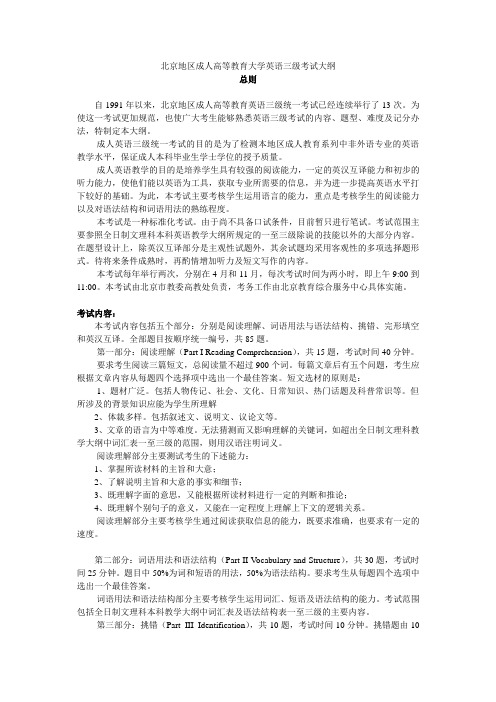
北京地区成人高等教育大学英语三级考试大纲总则自1991年以来,北京地区成人高等教育英语三级统一考试已经连续举行了13次。
为使这一考试更加规范,也使广大考生能够熟悉英语三级考试的内容、题型、难度及记分办法,特制定本大纲。
成人英语三级统一考试的目的是为了检测本地区成人教育系列中非外语专业的英语教学水平,保证成人本科毕业生学士学位的授予质量。
成人英语教学的目的是培养学生具有较强的阅读能力,一定的英汉互译能力和初步的听力能力,使他们能以英语为工具,获取专业所需要的信息,并为进一步提高英语水平打下较好的基础。
为此,本考试主要考核学生运用语言的能力,重点是考核学生的阅读能力以及对语法结构和词语用法的熟练程度。
本考试是一种标准化考试。
由于尚不具备口试条件,目前暂只进行笔试。
考试范围主要参照全日制文理科本科英语教学大纲所规定的一至三级除说的技能以外的大部分内容。
在题型设计上,除英汉互译部分是主观性试题外,其余试题均采用客观性的多项选择题形式。
待将来条件成熟时,再酌情增加听力及短文写作的内容。
本考试每年举行两次,分别在4月和11月,每次考试时间为两小时,即上午9:00到11:00。
本考试由北京市教委高教处负责,考务工作由北京教育综合服务中心具体实施。
考试内容:本考试内容包括五个部分:分别是阅读理解、词语用法与语法结构、挑错、完形填空和英汉互译。
全部题目按顺序统一编号,共85题。
第一部分:阅读理解(Part I Reading Comprehension),共15题,考试时间40分钟。
要求考生阅读三篇短文,总阅读量不超过900个词。
每篇文章后有五个问题,考生应根据文章内容从每题四个选择项中选出一个最佳答案。
短文选材的原则是:1、题材广泛。
包括人物传记、社会、文化、日常知识、热门话题及科普常识等。
但所涉及的背景知识应能为学生所理解2、体裁多样。
包括叙述文、说明文、议论文等。
3、文章的语言为中等难度。
无法猜测而又影响理解的关键词,如超出全日制文理科教学大纲中词汇表一至三级的范围,则用汉语注明词义。
2020大学英语三级考试大纲(B级)

2020大学英语三级考试大纲(B级) 2020大学英语三级考试大纲(B级)一、考试对象本大纲适用于修完《基本要求》B级所规定的全部内容的高等职业教育、普通高等专科教育、成人高等教育和本科办二级技术学院各非英语专业的学生。
二、考试性质本考试的目的是考核考生的语言知识、语言技能和使用英语处理相关一般业务和涉外交际的基本水平,其性质是教学---水平考试。
三、考试方式与内容考试方式为笔试,包括五个部分:听力理解、语汇用法和语法结构、阅读理解、翻译(英译汉)和写作(或汉译英)。
考试范围限于《基本要求》B级所规定的全部内容。
第一部分:听力理解(Listening Comprehensive)测试考生理解所听问题并做出恰当回答的水平、理解简短对话的水平和听写词语的水平。
听力材料的语速为每分钟100词。
听力材料以日常交际和简单的业务交际内容为主。
词汇限于《基本要求》的“词汇表”中B级2,500词的范围,交际内容涉及《基本要求》中的“交际范围表”所列的B级挺立的范围。
本部分的得分占总分的15%。
测试时间为15分钟。
第二部分:词汇用法和语法结构(Vocabulary and Structure)测试考生使用词语和语法知识的水平。
测试范围限于《基本要求》中的“词汇表”B级(2500词)和“语法结构表”所规定的全部内容。
本部分的得分占总分的15%。
测试时间为15分钟。
第三部分:阅读理解(Reading Comprehension)测试考生从书面文字材料获取信息的水平。
总阅读量约800词。
本部分测试的文字材料以一般性阅读材料(科普、文化、社会、常识、经贸、人物等)为主,也包括简单的应用性文字,不包括诗歌、小说、散文等文学性材料,其内容能为各专业学生所理解。
阅读材料涉及的语言技能和词汇限于《基本要求》中的“阅读技能表”中与B级要求相对应的技能范围和“词汇表”B级中2,500词的范围;阅读材料涉及的应用性内容限于《基本要求》中“交际范围表”B级所规定的读译范围,如:便条、通知、简短信函、简明广告、简明说明书、简明规范等。
全国英语等级考试三级 考试大纲
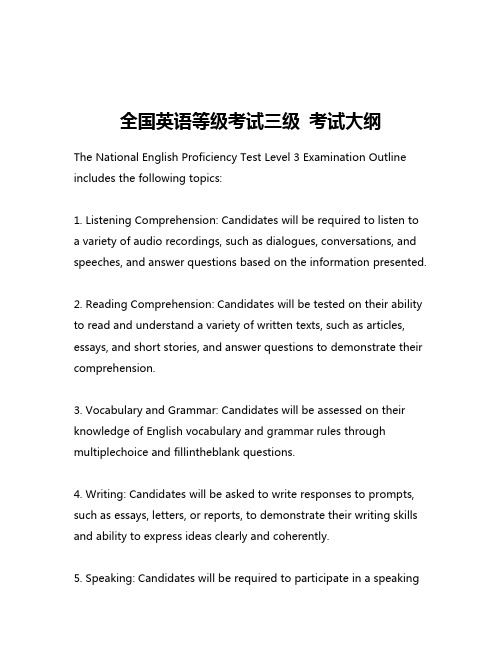
全国英语等级考试三级考试大纲The National English Proficiency Test Level 3 Examination Outline includes the following topics:1. Listening Comprehension: Candidates will be required to listen toa variety of audio recordings, such as dialogues, conversations, and speeches, and answer questions based on the information presented.2. Reading Comprehension: Candidates will be tested on their ability to read and understand a variety of written texts, such as articles, essays, and short stories, and answer questions to demonstrate their comprehension.3. Vocabulary and Grammar: Candidates will be assessed on their knowledge of English vocabulary and grammar rules through multiplechoice and fillintheblank questions.4. Writing: Candidates will be asked to write responses to prompts, such as essays, letters, or reports, to demonstrate their writing skills and ability to express ideas clearly and coherently.5. Speaking: Candidates will be required to participate in a speakingtest, in which they will engage in conversations, roleplays, and presentations to demonstrate their speaking proficiency and pronunciation.Overall, the Level 3 Examination aims to assess candidates' English language skills in listening, reading, writing, and speaking, and to determine their proficiency level in English language communication.。
英语二三级词汇大纲
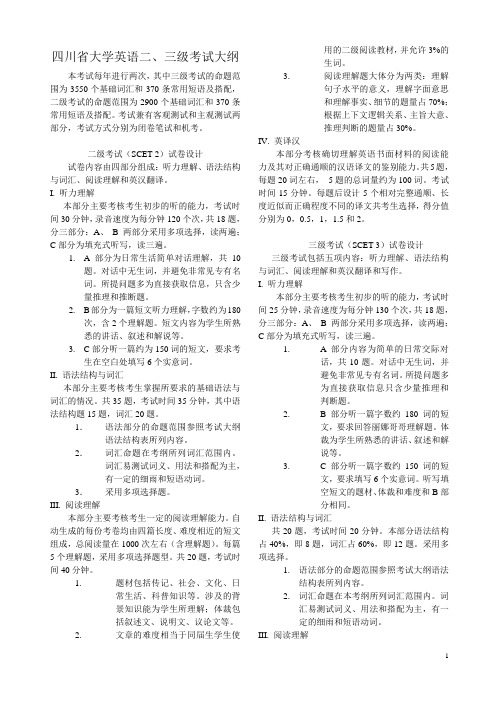
四川省大学英语二、三级考试大纲本考试每年进行两次,其中三级考试的命题范围为3550个基础词汇和370条常用短语及搭配,二级考试的命题范围为2900个基础词汇和370条常用短语及搭配。
考试兼有客观测试和主观测试两部分,考试方式分别为闭卷笔试和机考。
二级考试(SCET-2)试卷设计试卷内容由四部分组成:听力理解、语法结构与词汇、阅读理解和英汉翻译。
I. 听力理解本部分主要考核考生初步的听的能力,考试时间30分钟,录音速度为每分钟120个次,共18题,分三部分:A、B 两部分采用多项选择,读两遍;C部分为填充式听写,读三遍。
1.A部分为日常生活简单对话理解,共10题。
对话中无生词,并避免非常见专有名词。
所提问题多为直接获取信息,只含少量推理和推断题。
2.B部分为一篇短文听力理解,字数约为180次,含2个理解题。
短文内容为学生所熟悉的讲话、叙述和解说等。
3.C部分听一篇约为150词的短文,要求考生在空白处填写6个实意词。
II. 语法结构与词汇本部分主要考核考生掌握所要求的基础语法与词汇的情况。
共35题,考试时间35分钟,其中语法结构题15题,词汇20题。
1.语法部分的命题范围参照考试大纲语法结构表所列内容。
2.词汇命题在考纲所列词汇范围内。
词汇易测试词义、用法和搭配为主,有一定的细雨和短语动词。
3.采用多项选择题。
III. 阅读理解本部分主要考核考生一定的阅读理解能力。
自动生成的每份考卷均由四篇长度、难度相近的短文组成,总阅读量在1000次左右(含理解题)。
每篇5个理解题,采用多项选择题型。
共20题,考试时间40分钟。
1.题材包括传记、社会、文化、日常生活、科普知识等。
涉及的背景知识能为学生所理解;体裁包括叙述文、说明文、议论文等。
2.文章的难度相当于同届生学生使用的二级阅读教材,并允许3%的生词。
3.阅读理解题大体分为两类:理解句子水平的意义,理解字面意思和理解事实、细节的题量占70%;根据上下文逻辑关系、主旨大意、推理判断的题量占30%。
四川大学英语三级考试SCET—3大纲
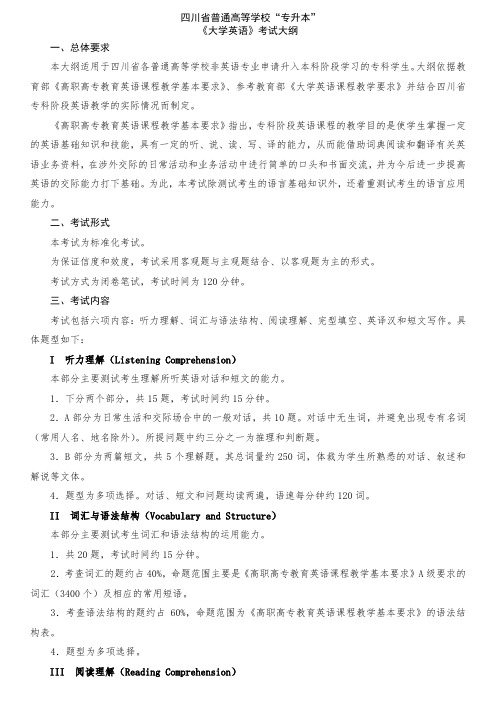
四川省普通高等学校“专升本”《大学英语》考试大纲一、总体要求本大纲适用于四川省各普通高等学校非英语专业申请升入本科阶段学习的专科学生。
大纲依据教育部《高职高专教育英语课程教学基本要求》、参考教育部《大学英语课程教学要求》并结合四川省专科阶段英语教学的实际情况而制定。
《高职高专教育英语课程教学基本要求》指出,专科阶段英语课程的教学目的是使学生掌握一定的英语基础知识和技能,具有一定的听、说、读、写、译的能力,从而能借助词典阅读和翻译有关英语业务资料,在涉外交际的日常活动和业务活动中进行简单的口头和书面交流,并为今后进一步提高英语的交际能力打下基础。
为此,本考试除测试考生的语言基础知识外,还着重测试考生的语言应用能力。
二、考试形式本考试为标准化考试。
为保证信度和效度,考试采用客观题与主观题结合、以客观题为主的形式。
考试方式为闭卷笔试,考试时间为120分钟。
三、考试内容考试包括六项内容:听力理解、词汇与语法结构、阅读理解、完型填空、英译汉和短文写作。
具体题型如下:I 听力理解(Listening Comprehension)本部分主要测试考生理解所听英语对话和短文的能力。
1.下分两个部分,共15题,考试时间约15分钟。
2.A部分为日常生活和交际场合中的一般对话,共10题。
对话中无生词,并避免出现专有名词(常用人名、地名除外)。
所提问题中约三分之一为推理和判断题。
3.B部分为两篇短文,共5个理解题。
其总词量约250词,体裁为学生所熟悉的对话、叙述和解说等文体。
4.题型为多项选择。
对话、短文和问题均读两遍,语速每分钟约120词。
II 词汇与语法结构(Vocabulary and Structure)本部分主要测试考生词汇和语法结构的运用能力。
1.共20题,考试时间约15分钟。
2.考查词汇的题约占40%,命题范围主要是《高职高专教育英语课程教学基本要求》A级要求的词汇(3400个)及相应的常用短语。
3.考查语法结构的题约占60%,命题范围为《高职高专教育英语课程教学基本要求》的语法结构表。
新大纲大学英语三级College English Test Band Three-3

College English Test Band Three (Three)Part I Listening Comprehension (30 marks, 30 minutes)Section ADirections:In this section, you will hear 10 short conversations. At the end of each conversation, a question will be asked about what was said. Both the conversation and the question will be spoken only once.After each question, there will be a pause. During the pause, you must read the 4 choices marked A),B), C) and D), and decide which is the best answer. Then mark the corresponding letter on theAnswer Sheet with a single line through the centre.1. A) Librarian and student. B) Boss and secretary.C) Operator and caller. D) Customer and repairman.2. A) She is planning a trip to Los Angeles.B) She has never been to Los Angeles before.C) She doesn't like Los Angeles.D) She wants to go to Los Angeles with the man.3. A) Find a large room. B) Buy two bookshelves.C) Sell the old table. D) Rearrange the furniture.4. A) At a hotel. B) At home. C) At an office. D) At a restaurant.5. A) She will save stamps for the man's sister.B) She can't give stamps to the man's sister. .C) She will no longer get letters from Canada.D) She has given the stamps to the man's roommate.6. A) Channel 4. B) Channel C) Channel 5. D) Channel 18.7. A) The man is a good player. B) She knows the man's brother.C) She wants to watch her brother play. D) She is not interested in football.8. A) 15 people. B) 25 people. C) 20 people. D) 30 people.9. A) Frank will come back at eight. B) Frank will be late.C) Frank won't come back that night. D) Frank will come back earlier.10. A) He has never taken a train.B) He got lost in the train station once.C) He doesn't know where the new train station is.D) He can't provide any useful information.Section BDirections: In this section, you will hear 3 short passages. At the end of each passage, you will hear some questions. The passage will be read twice and the questions will be spoken only once. After eachquestion, there will be a pause. During the pause, you must read the 4 choices marked A), B), C)and D), and decide which is the best answer. Then mark the corresponding letter on the AnswerSheet with a single line through the centre.Passage 1Questions 11 to 13 are based on the passage you have just heard.11. A) Ants. B) Beasts. C) Elephants. D) Bees.12. A) A scientist. B) A villager.C) An angry resident. D) A member of Save the Bee group.13. A) They attacked the bees. B) They made loud noises.C) They ran away. D) They wandered around.Passage 2Questions 14 to 16 are based on the passage you have just heard.14. A) On which days people should work.B) How the week is divided into days.C) Which day begins the week.D) How many weeks there are in a month.15. A) The weekend has decreased in length.B) People work fewer days per week.C) People work more hours each day.D) The number of national holidays has increased.16. A) It would make the workday longer.B) It would create much more free time.C) It would make leisure activities expensive.D) It would allow people to work on the weekend.Passage 3Questions 17 to 20 are based on the passage you have just heard.17. A) She had the chance to ride horses.B) She had her lessons at home.C) She was not allowed to swim.D) She had a very talented musician as her teacher.18. A) Interviewing famous people. B) Talking to journalists.C) Eating seafood. D) Taking photos.19. A) For another 3 years. B) 129 years in total.C) 80 years in total. D) Her whole lifetime.20. A) Because she had a very successful family life.B) Because she wrote back to all her fans.C) Because she tried her best to serve the country.D) Because her interests are similar to those of the general public.Section CDirections: In this section, you will hear a passage 3 times. When the passage is read for the first time, you should listen carefully for its general idea. When the passage is read for the second time, you arerequired to fill in the blanks numbered from 21 to 27 with the exact words you have just heard. Forblanks numbered from 28 to SO you are required to fill in the missing information. For these blanks,you can either use the exact words you have just heard or write down the main points in your ownwords. Finally, when the passage is read for the third time, you should check what you have written.Boxing Day is the following day after Christmas Day. Like Christmas Day, it is also a (21) _________ holiday in England. The name goes back to medieval times, more than (22) _________ years ago, when alms boxes were placed at the back of every church to (23) ___________ money for the poor. Traditionally, it is on the day that the alms box at every English church is (24) __________ and the contents are distributed to the poor.Historians say the holiday (25) ___________ because servants were required to work on Christmas Day, but took the (26) __________ day off. As servants prepared to leave to visit their families, their employers would (27) ___________ them with Christmas boxes.During the late 18th century, Lords and Ladies of the manor would "box up" their leftover food, or sometimes gifts and distribute them the day after Christmas to people (28) _____________________________ .(29) __________________________________________________. It is customary for householders to give small gifts or tips to regular visiting trades people (the milkman, dustman, coalman, paper boy, etc.) and, in some work places, (30) ______________________________________________ .Part II Reading Comprehension (40 marks, 40 minutes)Section ADirections:There, are 3 passages in this section. Each passage is followed by some questions or unfinished statements. For each of them there are 4 choices marked A), B), C) and D). You should decide onthe best choice and mark the corresponding letter on the Answer Sheet with a single line through thecenter.Passage 1Questions 31 to 35 are based on the following passage:Effective communication with people of different cultures is especially challenging. Cultures provide people with ways of thinking—ways of seeing, hearing, and interpreting the world. Thus the same words can mean different things to people from different cultures, even when they speak the "same" language. When thelanguages are different, and translation has to be used to communicate, the potential for misunderstandings increases.Stella Ting-Toomey describes three ways in which culture interferes with effective cross-cultural understanding. First is what she calls "cognitive constrains (认知约束)". These are the frames of reference or world views that provide a background that all new information is compared to or inserted into.Second are "behavior constraints". Each culture has its own rules about proper behavior which affect verbal (用言辞的) and nonverbal communication. Whether one looks the other person in the eye or not; whether one says what one means openly or talks around the issue; how close people stand to each other when they are talking—all of these and many more are rules of politeness which differ from culture to culture.Ting-Toomey's third factor is "emotional constraints". Different cultures regulate the display of emotion differently. Some cultures get very emotional when they are debating an issue. They shout, they cry, they exhibit their anger, fear, and other feelings openly. Other cultures, on the other hand, try to keep their emotions hidden.All of these differences tend to lead to communication problems. If the people involved are not aware of the potential for such problems, they are even more likely to fall victim to them, although it takes more than awareness to overcome these problems and communicate effectively across cultures.31. What poses challenges for effective communication?A) Cultural differences. B) Language differences.C) Words with different meaning. D) Unsuccessful interpretation and translation.32. The expression "frames of reference" (Line 3, Para. 2) most probably refers to ____________ .A) the sum total of old and new informationB) the main ideas and facts that something is based onC) knowledge and beliefs that influence the way one thinksD) some reference materials that one can look up when necessary33. With regard to "behavior constraints", Stella Ting-Toomey means that _______________ .A) rules about proper behavior vary from culture to cultureB) people should try to be straightforward when communicatingC) eye contact is very important in interpersonal communicationD) proper distance should always be kept in mind when communicating34. When debating an issue, ________________ .A) people get angry easilyB) people tend to get over-excitedC) people may show their feelings differentlyD) people should try to hide their true feelings35. According to the last paragraph, to overcome communication problems, people should _____________ .A) show more understanding of other culturesB) learn the strategy of effective communicationC) be involved in communication as much as possibleD) be aware of the potential danger of such problemsPassage 2Questions 36 to 40 are based on the following passage:Whenever I find myself banking on future good fortune, I tend to think, "Don't count your chickens before they hatch (孵化)."Germans express the same idea like this, "You have to catch the hare (野兔) before you can roast him." The French say: "You can't sell the bear's skin until you've caught him."Proverbs (谚语) abound in all languages. We use proverbs to make points more convincingly and more memorably than most of us could otherwise manage. We also use proverbs because they lend a measure of authority to our opinions, suggesting that what we are saying is simply common sense.Yet proverbial wisdom can be contradictory. We warn the cautious against hesitation with "He who hesitates is lost," but we also warn the bold, "Look before you leap." We may say that "Absence makes the heart grow fonder," but we also say, "Out of sight, out of mind.""Proverbs are not universal truths," says Wolfgang Mieder, professor of German at the University of Vermont. "Proverbs represent life; therefore, there will be contradictory proverbs."I admit, however, to having once spent several uncomfortable minutes in Japan after having come out with "The child of a frog is a frog," the Japanese version of "The apple doesn't fall far from the tree"—only to be met with blank, uncomprehending stares. It seems that the Japanese word for "frog" sounds much like the Japaneseverb "to return". My hosts must have thought that I was saying something like The Return of Frog-Boy.When people at the table finally grasped what I was trying to say, they burst into laughter. It gave me a perfect opening for "Fall down seven times, get up eight." That's the Japanese version of "If at first you don't succeed ... try, try again."36. What does the phrase "bank on" (Line 1, Para. 1) probably mean?A) To invest. B) To look for. C) To depend on. D) To work hard.37. According to the passage, which of the following is a reason why people use proverbs?A) Proverbs are easy to memorize. B) Proverbs are about popular wisdom.C) Proverbs can be found in all languages. D) Proverbs make conversations interesting.38. The two pairs of proverbs in Para. 4 are used to illustrate that ____________ .A) proverbs should be used cautiously B) proverbs can express opposite ideasC) proverbs can sometimes be misleading D) proverbs are created by ordinary people39. Why did the author's attempt at using a proverb fail?A) Because he misunderstood the proverb.B) Because his Japanese friends lacked humor.C) Because he mispronounced a Japanese word.D) Because his Japanese friends didn't like proverbs.40. What does the proverb "The apple doesn't fall far from the tree" (Para. 6) mean?A) Never give up in the face of difficulty.B) Never assume that you're going to be lucky.C) When you miss someone, you love him or her more.D) A child often grows up to be very similar to his or her parents.Passage 3Questions 41 to 45 are based on the following passage:The term "culture shock" was originally coined to explain the intense experiences of people who found themselves on overseas assignments in roles such as diplomats (外交官), international students, technical assistance advisors, or businesspeople. Over the last thirty years, the term has expanded to include other types of experiences people have when they move across cultural boundaries within any one country. Occasionally, culture shock is used to explain reactions to the new and the unfamiliar. Examples include going away to college, getting married, or being forced to go on welfare after years of productive employment.The complaints people have when experiencing culture shock are very similar, whether they are international students, overseas businesspeople, or members of an underrepresented ethnic group. Such individuals experience a sense of frustration (沮丧) and helplessness at their inability to meet their everyday needs. They feel lonely and find it hard to meet people and to develop international relationships. Victims of culture shock often become suspicious of others and come to believe that others are "out to get them". People also report a predictable set of physical symptoms. They complain of stomachaches, inability to sleep, headaches, general feelings of tiredness, mild depression, and a lack of enthusiasm for life.Many organizations now sponsor (赞助) programs to help prepare people for life's transitions (转折). Most commonly called "cross-cultural training programs", one of the goals of such programs is to introduce people to various experiences they are likely to encounter. During the programs, participants are commonly told that the experiences associated with "culture shock" are normal and are to be expected. Knowledge of what culture shock is, how frequently it is experienced, and effective coping strategies can aid in reducing people's stress.41. Who were the victims of culture shock when the term was first created?A) The newly-weds. B) College freshmen.C) People who were sent overseas. D) People newly recruited in the military.42. When do people suffer from culture shock?A) When they are forced to leave their original jobs.B) When they have to move from one place to another.C) When they express their complaints about something.D) When they have to deal with something new and unfamiliar.43. Which of the following is true of people suffering from culture shock?A) They don't trust others. B) They can't live by themselves.C) They don't want to meet people. D) They will have mental disorder.44. What is the aim of "cross-cultural training programs"?A) To help people behave normally. B) To reduce people's stress from life.C) To prepare people for culture shock. D) To share experiences of culture shock.45. Which of the following is the best title for the passage?A) Culture Shock. B) Cross-cultural Training.C) Experiencing Culture Shock. D) Symptoms of Culture Shock.Section BDirections:In this section, there is a passage with 10 blanks. You are required to select one word for each blank from a list of choices given in a word bank following the passage. Read the passage throughcarefully before making your choices. Each choice in the bank is identified by a letter. Please markthe corresponding letter for each item on the Answer Sheet with a single line through the centre.You may not use any of the words in the bank more than once.It's the first day of your Introduction to Business course. You take notes as the instructor starts her lecture. She discusses such (46) _________ as "affective orientation (情感适应) towards others" and "organizational design". She (47) __________ to the importance of "corporate culture". You're (48) ___________ with most of these concepts and not sure how to (49) ___________ some of the terms. At home you learn more about them from reading the textbook assignment. The next lecture makes more sense. As the course (50) ___________ . you learn more business concepts. By the end of the semester, you can look back at the first day of class and laugh at your confusion.Every academic subject is based on (51) __________ core concepts. In English composition, the writing process is a core concept. In business and law, the concept of a (52) ___________ provides the basis of many transactions (交易). Among the many key concepts in biology is evolution, and in computer science, the key concepts include (53) ___________ and programming.A concept is an idea, and all aspects of our lives (54) ___________ ideas. The US government is based on the concepts of freedom and democracy. In the workplace, the concepts of ambition and success apply. Our relationships with others are (55) ___________ on such concepts as love and trust, responsibility and fairness.A. software I. learnB. engage J. involveC. relates K. machineD. built L. progressesE. moves M. conceptsF. spell N. contractG certain O. refersH. unfamiliarPart III Integrated Testing (15 marks, 20 minutes)Section ADirections:There are 20 blanks in the following passage. For each blank there are 4 choices marked A), B), C) and D). You should choose the ONE that best fits into the passage. Then mark the correspondingletter on the Answer Sheet with a single line through the center.Canada like many other industrial nations is in economiccrisis. The government (56) _________ that in 2009 the economy will shrink (57) ________ at least 7%. And yet, there are some good news coming from or (58) _________ to the real estate market. The housing starts are again going up, (59) ________ significantly. The housing affordability is also moving up, (60) _________ more people have to spend less to become or to remain owners. The inflation (通货膨胀) is under (61) _________ and the central bank promises to keep the main rates at their historic low levels. Let's be clear, the Canadian economy cannot overcome the crisis alone, (62) _______ its high dependency on foreign trade. (63) ________ , if the United States is in crisis (80% of the trade is with this country alone), 56. A) protectsC) pretends57. A) atC)by58. A) relatedC) associated59. A) butC) or60. A) providingC) meaning61. A) wayC) controlB) projectsD) precedesB) inD) onB) concernedD) conformedB) andD) asB) helpingD) assumingB) threatD) pressureCanada will be in crisis. (64) _______ , these recent numbers show that the crisis may be milder than south of the border.The seasonally adjusted annual rate of housing starts increased to 154,700 units in March (65) _______ 136,100 units in February, according to Canada Mortgage (抵押) and Housing Corporation. There are more starts in the two key provinces, Ontario and Quebec, (66) _______ almost two thirds of the entire population lives. There is, however, some decline in British Columbia, in Atlantic Canada, and in the Prairies. In the (67) ________ , the main reason is falling energy prices.There is some improved housing affordability, according to the (68) ________ housing report by the Royal Bank of Canada. The sharp deteriorating (恶化) (69) ________ in RBC's affordability measures from mid-2004 to early 2008 has been reversed in the past year. Compared with a year (70) ________ , RBC's measures improved 2.3 to 3.5 percentage points due primarily to (71) ________ lending rates. The housing affordability measures the proportion of pre-tax household income needed to service the costs of owning a home. The affordability for detached bungalow (平房) is now (72) _________ 43.7%, the standard townhouse is at 35.4%, the standard condo (分套购置的公寓) is at 30.1%, and the standard two-story home is at 50%). The affordability measure for a detached bungalow for Canada's largest cities is as (73) ________ : Vancouver 70.3%, Toronto 51.3%, Calgary 42.7%, Ottawa 42.7% and Montreal 39.4%.The Bank of Canada says it will (74) _________ the key-lending rate at its historic low level of 0.25% until June 2010, and if that doesn't help Canada (75) _________ the recession (经济衰退) it will take less conventional measures like buying out governmental and corporate papers. 62. A) giveC) gave63. A) In other wordsC) In this case64. A) MoreoverC) Furthermore65. A) byC) over66. A) thatC) when67. A) latterC) beginning68. A) fastestC) most69. A) speedC) trend70. A) earlierC) ago71. A) higherC) more72. A) inC) at73. A) followC) follows74. A) keepC) stay75. A) succeedC) surpassB) givenD) givingB) In other aspectsD) In this senseB) NeverthelessD) ConsequentlyB) upD) fromB) whichD) whereB) formerD) endB) latestD) leastB) rateD)tendencyB) previousD) afterB) lowerD) lessB) onD) byB) followedD) followingB) remainD) standB) subjectD) surviveSection BDirections:In this section there is a short passage followed by 5 questions or incomplete statements. Read the passage carefully. Then answer the questions or complete the statements with no more than 10words. Please write your answers on Answer Sheet 2.The blues are calling, Manila. Are you listening?There's a worldwide blues explosion going on. In the US, birthplace of the blues, the number of music lounges (雅座酒吧) devoted to blues has grown over 50 percent since 1990 to 1,360, according to Fortune magazine. Among the most notable additions are the House of Blues, established by the legendary (传奇式的) creator of the Hard Rock Cafe, and Fleetwood's, set up by the Fleetwood Mac drummer.If anything, the blues are even more popular in Europe. Many US blues musicians have lived there at some time or another. Europeans consider the blues a serious art form and treat these old-time bluesmen with great respect. Seventy percent of blues record sales worldwide, rather surprisingly, take place in Europe. The best selling blues album (密纹唱片) in the world right now is From the Cradle by English superstar Eric Clapton, who with this album pays respect to the inspiration of his music all these years.The blues have even surrounded the Philippines. Japan and Australia have flourishing (蒸蒸日上的) blues scenes, with many well-established local players and frequent concerts by visiting blues legend.While the explosion is booming worldwide, in Manila it's more like a firecracker (鞭炮) pop. But things are changing. There's sudden interest, scattered at the moment, but definite, cracking through Manila.Of all the countries, the Philippines should be listening carefully to the blues. Many of the conditions that faced the US bluesmen and gave birth to the blues, from the early days in the Southern cotton fields to the urban slums (贫民窟) of today, bear surprising similarities to conditions here in the Philippines.Questions:76. Where did the blues first start?___________________________________________________________________________ .77. Among the most notable additions of music lounges devoted to blues are ______________________________________________________________________________________ .78. The blues is most popular in _______________________________________________________________ .79. The growing interest in the blues in Japan and Australia is reflected by ________________________________________________________________________________________ .80. The reason why there is a sudden interest in the blues in the Philippines is that the conditions there aresimilar to the conditions that _______________________________________________________________ . Part IV Writing (15 marks, 30 minutes)Directions: For this part, you are allowed 30 minutes to write an invitation letter. You should write at least 100 words, and base your composition on the outline given in Chinese below:你是学校学生会的主席,正在策划一年一度的外语节,你想邀请Dr. Smith,某外国公司CEO,出席你们的开幕式并致辞。
浙江省大学三级英语考试大纲
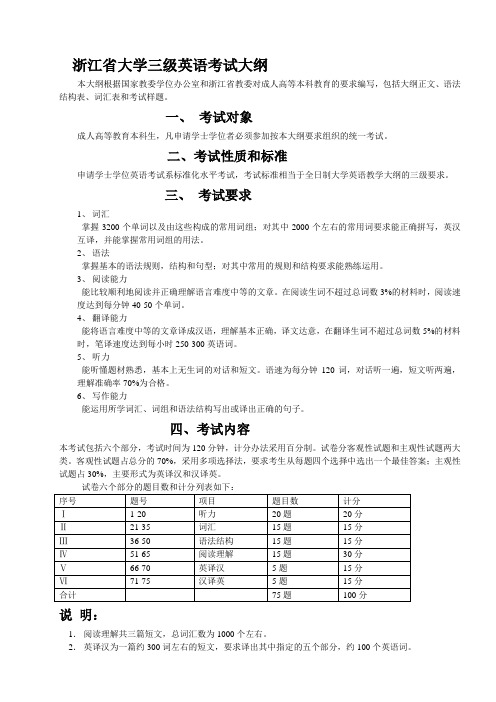
浙江省大学三级英语考试大纲本大纲根据国家教委学位办公室和浙江省教委对成人高等本科教育的要求编写,包括大纲正文、语法结构表、词汇表和考试样题。
一、考试对象成人高等教育本科生,凡申请学士学位者必须参加按本大纲要求组织的统一考试。
二、考试性质和标准申请学士学位英语考试系标准化水平考试,考试标准相当于全日制大学英语教学大纲的三级要求。
三、考试要求1、词汇掌握3200个单词以及由这些构成的常用词组;对其中2000个左右的常用词要求能正确拼写,英汉互译,并能掌握常用词组的用法。
2、语法掌握基本的语法规则,结构和句型;对其中常用的规则和结构要求能熟练运用。
3、阅读能力能比较顺利地阅读并正确理解语言难度中等的文章。
在阅读生词不超过总词数3%的材料时,阅读速度达到每分钟40-50个单词。
4、翻译能力能将语言难度中等的文章译成汉语,理解基本正确,译文达意,在翻译生词不超过总词数5%的材料时,笔译速度达到每小时250-300英语词。
5、听力能听懂题材熟悉,基本上无生词的对话和短文。
语速为每分钟120词,对话听一遍,短文听两遍,理解准确率70%为合格。
6、写作能力能运用所学词汇、词组和语法结构写出或译出正确的句子。
四、考试内容本考试包括六个部分,考试时间为120分钟,计分办法采用百分制。
试卷分客观性试题和主观性试题两大类。
客观性试题占总分的70%,采用多项选择法,要求考生从每题四个选择中选出一个最佳答案;主观性试题占30%,主要形式为英译汉和汉译英。
试卷六个部分的题目数和计分列表如下:说明:1.阅读理解共三篇短文,总词汇数为1000个左右。
2.英译汉为一篇约300词左右的短文,要求译出其中指定的五个部分,约100个英语词。
《大学英语》三级考试大纲

《大学英语》三级考试大纲(CET-3)课程编号:020001-40 适用专业:全院各专业考试方式:闭卷学时数:80学分数:4 执笔人:石贵生王凤香一、基本要求大学英语三级考试大纲(CET-3)是根据《大学英语教学大纲》关于三级的各项具体要求制定的。
教学大纲规定,学生学完三级应达到下列要求:1.词汇:掌握580—630个单词以及由这些单词构成的常用词组。
对其中300个左右的常用词要求拼写正确,能英汉互译,并掌握它们的基本用法。
2.听:能听懂英语讲课,对题材熟悉、句子结构简单、基本上没有生词、语速每分钟约120词的听力材料,两遍可以听懂,理解准确率以70%为合格。
3.说:能运用所学的功能意念进行简单的日常会话,能就教材的内容进行简短的问答。
4.读:能正确理解与课文难度相仿的文章。
学会基本阅读技能,阅读速度达到每分钟40个词。
阅读难度略低,生词不超过总数3%的材料,速度达到每分钟70词,理解准确率以70%为合格。
5.写:能运用学到的词汇、语法结构和功能意念连句成段。
三级考试只包括上述要求中的“词汇、听、读和写”四项,不包括第三项“说”的部分。
考试采用笔试形式。
对学生“说”的能力的测试,可在平时测验中测定。
三级考试的难易程度与《新编大学英语》和《大学英语》(全新版)系列教材第三册相适应。
试题中应有40%左右的内容与教材有较密切的关系。
其余60%的试题根据教学大纲的规定命题。
试卷中85%的试题采用多项选择题,分布在第I、第II、第III和第IV部分,占85分;15%的试题采用主观性试题(段落写作),分布在第V部分,占15分。
二、考试内容三级考试包括五个部分:一、听力理解(Listening Comprehension),二、阅读理解(Reading Comprehension),三、词语和语法结构(Vocabulary and Structure),四、完形填空(Cloze),五、组词成句或汉译英(Sentence Making and Translation)。
浙江省大学英语三级考试大纲2011版
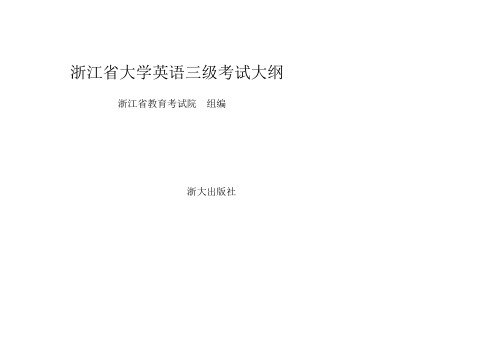
浙江省大学英语三级考试大纲浙江省教育考试院组编浙大出版社浙江省大学英语三级考试大纲一、总则浙江省大学英语三级考试(CET-3)是在浙江省教育考试院的主持和领导下,由浙江省大学外语教学研究会组织专家设计和开发,由浙江省教育考试院组织实施的一项大规模标准化考试,每年举行两次,考试对象为修完大学英语相应阶段课程的在校大学生。
二、大学英语三级考试概述1.试卷构成大学英语三级考试由四个部分组成:1)听力理解;2)阅读理解;3)综合测试;(备注:第三部分综合测试中,篇章问答和句子翻译二者选一。
)2.题型分解1)听力理解听力理解(Listening Comprehension)部分测试考生获取口头信息的能力。
录音材料采用标准的英式或美式英语朗读,语速为每分钟100词左右。
听力理解部分共30题,所占分值比例为30%,其中短对话占10%,长对话/短文理解占10%,短文听写占10%。
考试时间为30分钟。
短对话(Short Conversations)部分采用多项选择题的形式进行考核。
共10段,每段为一轮对话和一个问题。
每段短对话均朗读一遍,每个问题后留有15秒的答题时间。
长对话/短文理解(Long Conversations/Passages)部分采用多项选择题的形式进行考核。
共3篇长对话或短文,每篇长度200词左右。
每篇长对话或短文朗读两遍,每篇3~4题,共10题,每个问题后留有15秒的答题时间。
复合式听写(Compound Dictation)部分测试考生在不同层面上(从词汇到语篇层面)的听力理解能力。
这部分测试采用一篇200词左右的短文,删去若干个单词和句子,全文朗读三遍。
要求考生根据听到的内容填写所缺信息,所缺单词必须用原词填写,所缺句子信息既可按原文填写,也可用自己的语言表述。
2)阅读理解阅读理解(Reading Comprehension)部分测试考生通过阅读获取书面信息的能力以及考生对篇章语境中的词汇理解和运用能力。
SCET-3考试大纲

四川省大学英语三级考试大纲本考试命题范围暂定为3550个基础词汇和350条常用短语,内容分为客观测试和主观测试两大部分。
每年进行两次考试。
SCET-3包括五项内容:听力、语法结构与词汇、阅读理解、英汉翻译和写作。
听力:主要考核考生一定的听的能力及初步听写记录能力。
考试时间为25分钟,录音速度为每分钟130词左右,共18题,分为3部分:A、B两个部分采用多项选择,读两遍;C部分为填充式听写,读三遍。
A部分为简单的日常交际对话,共10题,含少量推断及判断题。
B部分为约180词短文,要求回答两个理解题。
C部分为约150词短文,要求填写6个实意词。
语法结构与词汇:共20题,考试时间为20分钟。
语法占40%,即8题;词汇占60%,即12题。
阅读理解:共20题,考试时间为35分钟。
由四篇短文组成,总阅读量在1200词左右。
英译汉:共5题,考试时间为10分钟。
其中四题选自第三部分阅读理解的四篇文章,每题20词左右;另一题按同等难度、长度另选。
每题后设计5个相对完整通顺、长度近似而正确度不同的译文,得分值分别为0,0.5,1,1.5,和2.写作:命题作文,要求在30分钟内写出100词左右的短文,内容切题,表达思想清楚,语言正确。
考试样卷中的注意事项1、试卷分AB卷时:将校名、姓名、学校代号、准考证号和试卷代号分别填写在答题纸、试卷二(含填充式听写和作文纸)上。
看清试卷一上的试卷代号,你现在做的是A卷,须在答题纸试卷代号栏相应字母A上画线。
画错或不画均判为零分,责任有考生自负。
多项选择题答案一定要坐在答题纸上,每题仅限一个答案,多选做答错处理。
选定以后,用2B铅笔在相应字母中部划一条横线,使用其他符号不给分。
画线浓度一定要盖过字母底色。
填充式听写和作文用钢笔或圆珠笔分别按要求写在试卷二中相应位置,并保持卷面整洁。
写在其他地方无效。
2、不分AB卷时:最后30分钟为作文时间。
此时监考人员将收回试卷一。
考试结束后,将试卷二和答题纸放在桌上不得带走。
四川省大学英语三级考试SCET

四川省大学英语三级考试SCET—3大纲总则本大纲的主要测试对象为四川省高等学校的非英语专业学生,其目的不仅是检查学生对所学英语课程的掌握程度,而且是鉴定该生是否达到大学英语三级水平。
因此,这种考试体现对学生学习的要求,具有水平测试的性质。
SCET—3是一种标准化考试。
根据普通高校大学英语教学大纲(修订本)的要求,考虑到我省大学英语教学的实际情况及其现有条件,本考试命题范围暂定为3550个基础词汇和350条常用短语,内容分为客观测试和主观测试两大部分,分别占试卷的72%和28%。
(详见计分办法)。
考试方法为闭卷考试。
本考试由四川省教育厅直接领导和组织,由四川省大学英语二、三级考试办公室具体实施,统一命题,统一测试,统一阅卷。
试卷设计SCET—3包括五项内容:听力、语法结构与词汇、阅读理解、英译汉和写作。
Ⅰ.听力(Listening):听力部分主要考核考生一定的听的能力和初步的书面表达能力。
本部分共15题,下分三个部分,考试时间20分钟。
A部分为日常生活和交际场合中的一般对话,共10题。
对话中无生词,并避免专有名词(常用人名、地名除外)。
所提问题中约有三分之一为推理和判断题。
B部分为一篇短篇听力材料,含2个理解题。
其总词量为150个左右,体裁为学生所熟悉的讲话、叙述和解说等。
上述两部分均采用多项选择。
读两遍。
C部分为听写填空。
在试卷上给出一篇意思相对完整,约150词左右的短文,其中有6个空格。
每个空格要求填入1----2个单词或1个短语。
全文朗读三遍。
第一遍全文朗读,没有停顿,供考生听懂全文内容;第二遍在有空格的句子后面有停顿,要求考生把听到的单词或短语填入空格;第三遍同第一遍,没有停顿,供考生进行核对。
“听写填空”短文的题材、体裁和难度与B部分相同。
以上A、B、C三部分的语速都为每分钟130个词左右。
Ⅱ.语法结构与词汇(Structure and Vocabulary)共20题,考试时间15分钟。
英语二三级词汇大纲

四川省大学英语二、三级考试大纲本考试每年进行两次,其中三级考试的命题范围为3550个基础词汇和370条常用短语及搭配,二级考试的命题范围为2900个基础词汇和370条常用短语及搭配。
考试兼有客观测试和主观测试两部分,考试方式分别为闭卷笔试和机考。
二级考试(SCET-2)试卷设计试卷内容由四部分组成:听力理解、语法结构与词汇、阅读理解和英汉翻译。
I. 听力理解本部分主要考核考生初步的听的能力,考试时间30分钟,录音速度为每分钟120个次,共18题,分三部分:A、B 两部分采用多项选择,读两遍;C部分为填充式听写,读三遍。
1. A部分为日常生活简单对话理解,共10题。
对话中无生词,并避免非常见专有名词。
所提问题多为直接获取信息,只含少量推理和推断题。
2. B部分为一篇短文听力理解,字数约为180次,含2个理解题。
短文内容为学生所熟悉的讲话、叙述和解说等。
3. C部分听一篇约为150词的短文,要求考生在空白处填写6个实意词。
II. 语法结构与词汇本部分主要考核考生掌握所要求的基础语法与词汇的情况。
共35题,考试时间35分钟,其中语法结构题15题,词汇20题。
1. 语法部分的命题范围参照考试大纲语法结构表所列内容。
2. 词汇命题在考纲所列词汇范围内。
词汇易测试词义、用法和搭配为主,有一定的细雨和短语动词。
3. 采用多项选择题。
III. 阅读理解本部分主要考核考生一定的阅读理解能力。
自动生成的每份考卷均由四篇长度、难度相近的短文组成,总阅读量在1000次左右(含理解题)。
每篇5个理解题,采用多项选择题型。
共20题,考试时间40分钟。
1. 题材包括传记、社会、文化、日常生活、科普知识等。
涉及的背景知识能为学生所理解;体裁包括叙述文、说明文、议论文等。
2.文章的难度相当于同届生学生使用的二级阅读教材,并允许3%的生词。
3. 阅读理解题大体分为两类:理解句子水平的意义,理解字面意思和理解事实、细节的题量占70%;根据上下文逻辑关系、主旨大意、推理判断的题量占30%。
大学英语艺体类Ⅲ级教学质量规格及考试大纲

大学英语艺体类Ⅲ级教学质量规格及考试大纲一.大学英语艺体类三级教学质量规格通过二级学习,考试成绩合格者,进入三级学习。
具体要求如下:1.词汇领会式掌握1800单词(其中复用式掌握的单词为1600),以及由这些词构成的常用词组(中学所掌握的单词和词组包括在内),并具有按照基本构词法识别生词的能力。
2.语法巩固和加深基本语法知识,提高在语篇水平上运用语法知识的能力。
3.阅读能力能顺利阅读语言难度中等的题材多样的文章,掌握中心大意,及说明中心大意的事实和细节,并能进行一定的分析、推理和判断,领会作者的观点和态度,阅读速度达到每分钟60词。
在阅读篇幅较长、难度略低、生词不超过总词数3%的材料时,能掌握中心大意,抓住主要事实和有关细节,阅读速度达到每分钟80词。
4.听的能力能听懂英语讲课,并能听懂题材熟悉、句子结构比较简单、基本上没有生词、语速为每分钟80词的简短会话、谈话、报道和讲座,掌握其中心大意,抓住要点和有关细节,领会讲话者的观点和态度。
5.说的能力能就教材内容和适当的听力材料进行问答和复述,能用英语进行一般的日常会话,能就所熟悉的话题经准备后作简短发言,表达思想比较清楚,语音、语调基本正确。
6.写的能力能在阅读难度与课文相仿的书面材料时做笔记、回答问题、撰写提纲,能就一定的话题或提纲在半小时内写出90词的短文,能写短信和便条,表达意思清楚,无重大语言错误。
7.译的能力能借助词典将难度略低于课文的英语短文译成汉语,理解正确,译文达意,译速为每小时170英语单词。
能借助词典将内容熟悉的汉语文字材料译成英语,译文达意,无重大语言错误,译速每小时170汉字。
二.大学英语艺体类三级考试大纲根据大学英语三级教学质量规格,制定考试大纲,所包涵的知识点、内容及考点如下:考试范围:课堂教学内容占70%,课外占30%难易度:容易:中等:较难的比例为4:4:2(一)、词汇部分I、词义辨析题, 行相近的词辨析II、连接词辨析题(1)连接代词:who, whom, whose, what, which, whoever, whatever, whichever, as。
广西师范大学学士学位英语考试大纲

广西师范大学学士学位英语考试大纲A、大学英语三级一、学位英语(三级)考试目的《大学英语课程教学要求(试行)》规定,大学英语课程是高校非英语专业大学生的一门重要的必修基础课程,其教学目标是培养学生掌握必需的、实用的英语知识和应用能力,具有阅读和翻译有关专业英文资料的初步能力以及简单的英语听说和写作能力,并为进一步提高英语水平和应用能力打下一定的基础。
本考试主要考核学生英语实际应用能力,同时也考核学生对语法结构和词汇用法的掌握程度。
本考试是一种标准化考试。
为保证试卷的信度,除翻译题是主观性试题外,其余试题都采用客观性的多项选择题形式。
二、学位英语(三级)考试概述1、试卷构成学位英语(三级)考试由六个部分构成:1)阅读理解;2)词汇;3)结构;4)完型填空;5)英译汉;6)汉译英。
各部分测试内容、题型和所占分值比例如下表所示:2、题型分解学位英语(三级)考试各部分所考核的内容、题型、答题方式如下:阅读理解(Reading Comprehension)部分测试学生通过阅读获取书面信息的能力。
所占分值比例为40%,考试时间40分钟。
阅读理解部分包括四篇短文。
均为多项选择题型,每篇长度为200-300词。
阅读部分测试考生在不同层面上的阅读理解能力,包括理解主旨大意和重要细节、综合分析、推测判断以及根据上下文推测词义等。
多项选择题型的短文后有若干个问题,考生根据对文章的理解,从每题的四个选项中选择最佳答案。
词汇(Vocabulary)共20题,所占分值比例为10%,考试时间10分钟。
题目为词和短语的用法。
要求考生从每题四个选择项中选出一个最佳答案。
词汇用法部分的目的是测试学生是否掌握词汇、短语的主要词义和用法。
考生掌握的词汇量应达到3500个单词以及由这些单词构成的常用词组。
(见《教学要求》参考词汇表)语法结构(Structure)共20题,所占分值比例为10%,考试时间10分钟。
题目为语法结构的具体运用。
要求考生从每题四个选择项中选出一个最佳答案。
- 1、下载文档前请自行甄别文档内容的完整性,平台不提供额外的编辑、内容补充、找答案等附加服务。
- 2、"仅部分预览"的文档,不可在线预览部分如存在完整性等问题,可反馈申请退款(可完整预览的文档不适用该条件!)。
- 3、如文档侵犯您的权益,请联系客服反馈,我们会尽快为您处理(人工客服工作时间:9:00-18:30)。
大学英语三级考试大纲
高等学校英语应用能力考试大纲(总述)
我国高等职业教育、普通高等专科教育和成人高等教育的教学目标是培养高级应用性人才,其英语教学应贯彻“实用为主,够用为度”的方针;既要培养学生具备必要的英语语言基础知识,也应强调培养学生运用英语进行有关涉外业务工作的能力。
高等学校英语应用能力考试就是为了检验高职高专学生是否达到所规定的教学要求而设置的考试。
本考试以《高职高专教育英语课程教学基本要求(试行)》(简称《基本要求》)为依据,既测试语言知识也测试语言技能,既测试一般性语言内容也测试与涉外业务有关的应用性内容。
考虑到目前我国高职高专学生英语入学水平的现状,《基本要求》将教学要求分为A级要求和B级要求,本考试也相对应的分为A级考试和B级考试。
修完《基本要求》规定的全部内容的学生可参加A级考试;修完《基本要求》B级规定的全部内容的学生可参加B级考试。
考试方式为笔试,测试语言知识和读、听、译、写四种技能。
口试正在规划之中,待时机成熟时实施。
客观性试题有信度较高、覆盖面广的优点,而主观性试题有利于提高测试的效度,能更好的检测考生运用语言的能力,为此本考试采用主客观题混合题型,以保证良好的信度和效度。
本考试按百分制计分,满分为100分。
60分及60分以上为及格;85分及85分以上为优秀。
考试成绩合格者发给“高等学校英语应用能力考试”相应级别的合格证书。
高等学校英语应用能力考试大纲(A级)
一、考试对象
本大纲适用于修完《基本要求》所规定的全部内容的高等职业教育、普通高等专科教育、成人高等教育和本科办二级技术学院各非英语专业的学生。
二、考试性质
本考试的目的是考核考生的语言知识、语言技能和使用英语处理有关一般业务和涉外交际的基本能力,其性质是教学---水平考试。
三、考试方式与内容
考试方式为笔试,包括五个部分:听力理解、语法结构、阅读理解、翻译(英
译汉)和写作(或汉译英)。
考试范围为《基本要求》对A级所规定的全部内容。
第一部分:听力理解(Listening Comprehensive)
测试考生理解所听对话、会话和简单短文的能力。
听力材料的语速为每分钟120词。
对话、会话和短文以日常生活和实用的交际性内容为主。
词汇限于《基本要求》的“词汇表”中3,400词的范围,交际内容涉及《基本要求》中的“交际范围表”所列的全部听说范围。
本部分的得分占总分的15%。
测试时间为15分钟。
第二部分:语法结构(Structure)
测试考生运用语法知识的能力。
测试范围包括《基本要求》中的“语法结构表”所规定的全部内容。
本部分的得分占总分的15%。
测试时间为15分钟。
第三部分:阅读理解(Reading Comprehension)
测试考生从书面文字材料获取信息的能力。
总阅读量约1,000词。
本部分测试的文字材料包括一般性阅读材料(文化、社会、常识、科普、经贸、人物等)和应用性文字,不包括诗歌、小说、散文等文学性材料,其内容能为各专业学生所理解。
其中,实用性文字材料约占60%。
阅读材料涉及的语言技能和词汇限于《基本要求》中的“阅读技能表”所列的全部技能范围和“词汇表”中3,400词的范围;除一般性文章外,阅读的应用文限于《基本要求》中“交际范围表”所规定的读译范围,如:函电、广告、说明书、业务单证、合同书、摘要、序言等。
主要测试以下阅读技能:
1.了解语篇和段落的主旨和大意。
2.掌握语篇中的事实和主要情节。
3.理解语篇上下文的逻辑关系。
4.对句子和段落进行推理。
5.了解作者的目的、态度和观点。
6.根据上下文正确理解生词的意思。
7.了解语篇的结论。
8.进行信息转换。
本部分的得分占总分的35%。
测试时间是40分钟。
第四部分:翻译------英译汉(Translation---English to Chinese)
测试考生将英语正确译成汉语的能力。
所译材料为句子和段落,包括一般性内容和实用性内容(各约占50%);所涉及的词汇限于《基本要求》的“词汇表”中3,400词的范围。
本部分的得分占总分的20%。
测试时间为25分钟。
第五部分:写作/汉译英(Writing/Translation----Chinese to English)测试考生套写应用性短文、信函,填写英文表格或翻译简短的实用性文字的能力。
本部分的得分占总分的15%。
测试时间为25分钟。
